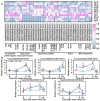Physiological and RNA-Seq Analyses on Exogenous Strigolactones Alleviating Drought by Improving Antioxidation and Photosynthesis in Wheat (Triticum aestivum L.)
- PMID: 37891963
- PMCID: PMC10604895
- DOI: 10.3390/antiox12101884
Physiological and RNA-Seq Analyses on Exogenous Strigolactones Alleviating Drought by Improving Antioxidation and Photosynthesis in Wheat (Triticum aestivum L.)
Abstract
Drought poses a significant challenge to global wheat production, and the application of exogenous phytohormones offers a convenient approach to enhancing drought tolerance of wheat. However, little is known about the molecular mechanism by which strigolactones (SLs), newly discovered phytohormones, alleviate drought stress in wheat. Therefore, this study is aimed at elucidating the physiological and molecular mechanisms operating in wheat and gaining insights into the specific role of SLs in ameliorating responses to the stress. The results showed that SLs application upregulated the expression of genes associated with the antioxidant defense system (Fe/Mn-SOD, PER1, PER22, SPC4, CAT2, APX1, APX7, GSTU6, GST4, GOR, GRXC1, and GRXC15), chlorophyll biogenesis (CHLH, and CPX), light-harvesting chlorophyll A-B binding proteins (WHAB1.6, and LHC Ib-21), electron transfer (PNSL2), E3 ubiquitin-protein ligase (BB, CHIP, and RHY1A), heat stress transcription factor (HSFA1, HSFA4D, and HSFC2B), heat shock proteins (HSP23.2, HSP16.9A, HSP17.9A, HSP21, HSP70, HSP70-16, HSP70-17, HSP70-8, HSP90-5, and HSP90-6), DnaJ family members (ATJ1, ATJ3, and DJA6), as well as other chaperones (BAG1, CIP73, CIPB1, and CPN60I). but the expression level of genes involved in chlorophyll degradation (SGR, NOL, PPH, PAO, TIC55, and PTC52) as well as photorespiration (AGT2) was found to be downregulated by SLs priming. As a result, the activities of superoxide dismutase (SOD), peroxidase (POD), and catalase (CAT) were enhanced, and chlorophyll content and photosynthetic rate were increased, which indicated the alleviation of drought stress in wheat. These findings demonstrated that SLs alleviate drought stress by promoting photosynthesis through enhancing chlorophyll levels, and by facilitating ROS scavenging through modulation of the antioxidant system. The study advances understandings of the molecular mechanism underlying SLs-mediated drought alleviation and provides valuable insights for implementing sustainable farming practice under water restriction.
Keywords: RNA-seq; ROS; antioxidation; drought; photosynthesis; strigolactones; wheat.
Conflict of interest statement
The authors declare no conflict of interest.
Figures









References
-
- Farooq M., Wahid A., Kobayashi N., Fujita D., Basra S.M.A. Plant drought stress: Effects, mechanisms and management. Sustain. Agric. 2009;29:153–188.
-
- Trnka M., Feng S., Semenov M.A., Olesen J.E., Kersebaum K.C., Rötter R.P., Semerádová D., Klem K., Huang W., Ruiz-Ramos M., et al. Mitigation efforts will not fully alleviate the increase in water scarcity occurrence probability in wheat-producing areas. Sci. Adv. 2019;5:eaau2406. doi: 10.1126/sciadv.aau2406. - DOI - PMC - PubMed
Grants and funding
LinkOut - more resources
Full Text Sources
Research Materials
Miscellaneous

